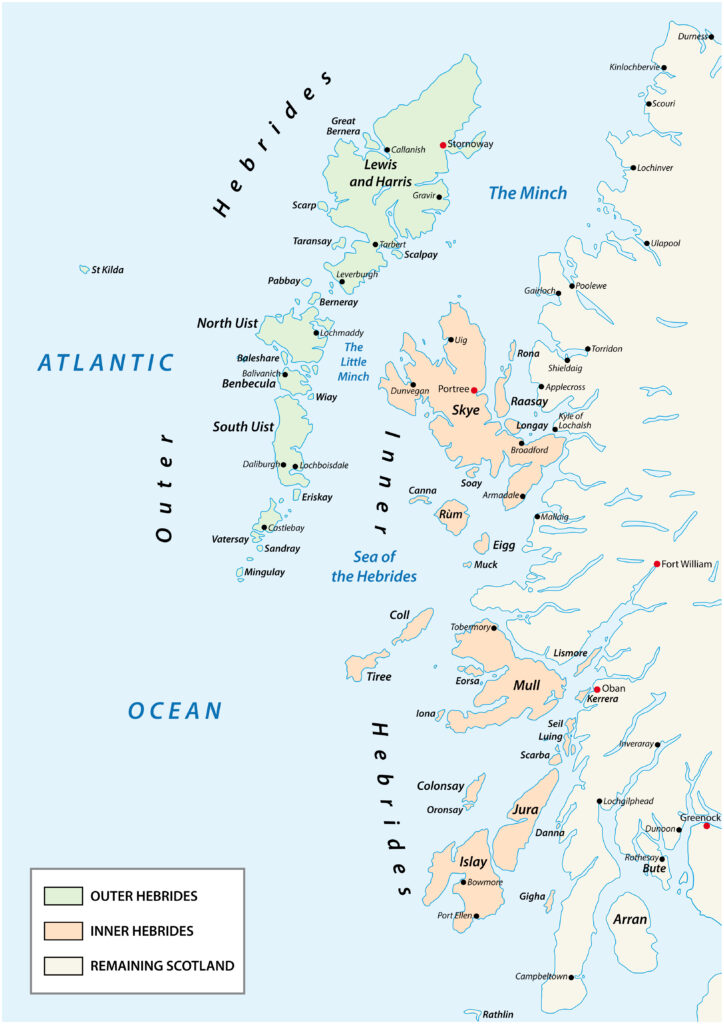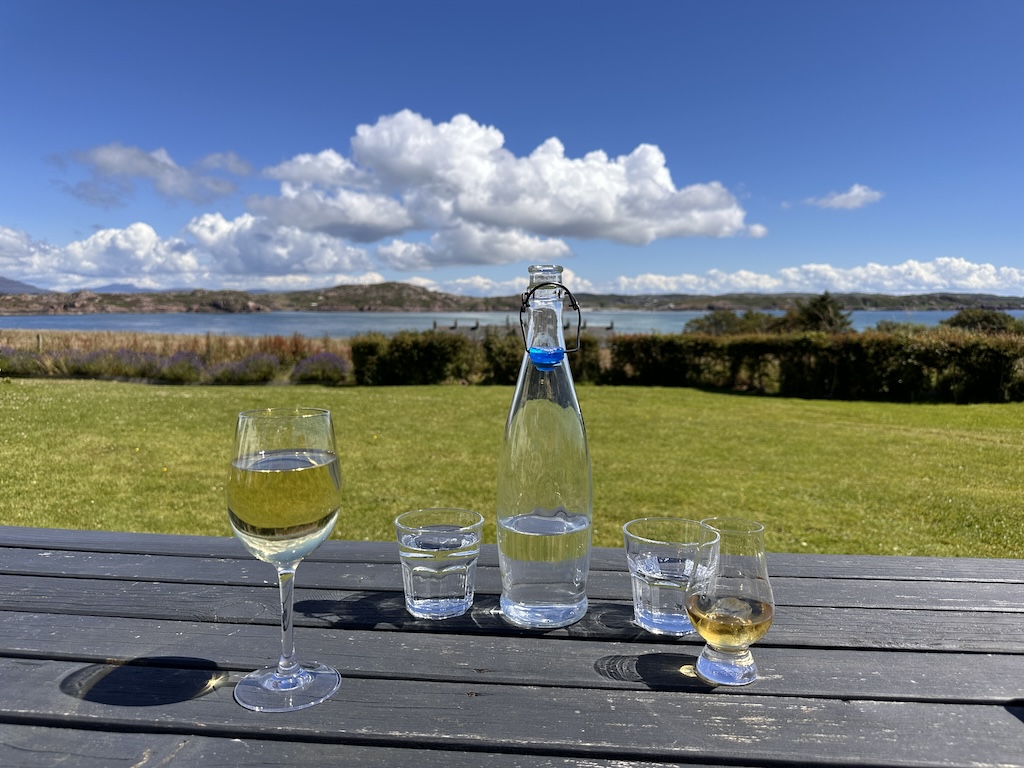There is a certain lore about the West Coast of Scotland. Unlike the East Coast, all angular and dominated by the large metropolitan centers of Edinburgh, Aberdeen, and Inverness, the West Coast is full of small villages looking out upon waters chock full of amoeba-shaped islands with curiosity-stirring names such as Rum and Muck. For local Scottish and English sailors – and for that matter Irish – who live in the more populated regions to the south, the Scottish West Coast is the holy grail of sailing destinations. And Karen and I were about to embark – in the prime summer holiday month of July – on a mission to probe the depths of its history and hidden secrets. With any luck, after a week of full-time motoring inside the Caledonian Canal, we might even rediscover the joy of sailing!


Out the Firth of Lorn, away from the hub-bub of Oban, the island of Mull stretches seaward like the lanky legs of a newborn fawn. But what the maps don’t convey was the striking height of its cliffs and the deeply rich green valleys carrying inland. We stopped for the night near the western tip where, unlike the abundant guest harbors of Scandinavia, we were on our own to get ashore using our own dinghy.


But one of Mull’s big attractions is actually a small off lying island. On Iona, as we dropped anchor in a wide open channel exposed to weather and errant ship captains, a robust stone structure came into view, the girth of which looked out of place in a landscape otherwise occupied by cottages and farmland. Here, back just a few years in 593, St Columba, an abbot from Ireland, chose this wee island for a monastery and thus established the spiritual center and birthplace of Christianity in Scotland. You could feel the roots of spirituality all around you. Despite several loads of ferry passengers disembarking, and later a small cruise ship, the island seemed to absorb humanity in a way that left just the sounds of birds chirping. Abundant sunshine made us feel transported to the peaceful Mediterranean coast of Spain. In thanks to St Columba’s hard work and dedication, we hydrated after our tour by way of the nectar of the vine and the distillery.


The island of Mull could be the home of a week’s worth of adventuring, but with headwinds in the forecast for the next several days, we took advantage of clear weather and set sail to the island of Muck some 30 nautical miles to the north. However, when I say ‘clear weather’, one must remember this is Scotland still, where, much to the dismay of our friends back home, the days on the water still require down jackets!

Part of the adventure of travel is all of the unexpected surprises that come your way. While Karen was on watch at the helm, she yelled down to me about something strange in the water. From the porthole I saw the long body of a dolphin. But it was very skinny. And, once we passed it on the downwind side, it became clear it was no animal, but a 30 meter long black plastic pipe, floating just at the surface, ready to play havoc with propellors and other underbody features of small boats like ours. In a fright, I called in a ‘pan-pan’ radio alert, giving our approximate latitude and longitude. The good folks at the Stornoway Coast Guard station hailed us back to take down the necessary details and repeat our navigational warning to all boaters in the area, in a more practiced, less staccato, delivery. Henceforth, for the rest of the sail, all eyes were focussed on every little dark shadow on the water’s surface.
The island of Muck is part of what is called the Small Isles Group, and Muck is the smallest of them all, including the area to anchor in its main harbor — Port Mor. We had been warned to leave plenty of room for the island’s ferry, which needed extra room to maneuver on its way to a large concrete ramp where an articulating section on its bow would unfold and give drivers the chance to roll onto the ramp without the risk of testing their buoyancy. Ashore, we found all the telltale signs of rural island life. Disorganized stacks of commercial fishing gear dominated the ferry landing. A small brightly painted shack was open 24/7 with a collection of island products, souvenirs and even frozen meats. If you found something you couldn’t do without, you simply left money in a metal box that also had a few bills and coins for making change. If math wasn’t your forte, a calculator was at hand to help determine your total charge. Leading away from the harbor, a new community building stood next to a micro-sized football pitch, and adjacent to the old community center, so hastily abandoned that doors and windows were left wide open. A few teenagers, treating us as invisible adults likely just as they do with their parents, were starting a game of pickup basketball on an equally micro-sized indoor court.

Alas, everything was small on this island and as the wind picked up in the evening, we started to feel, as a rocky shore full of white water lay directly off our stern, that these quarters were too tight. We reluctantly raised anchor at 10pm to find better accommodations, hoping to find success before we lost the remaining traces of daylight. We were rewarded with that and more. As we motored across to the island of Eigg, the sky to the west exploded into a canvas of orange and yellow as the sun set behind striated clouds. We could have very easily been down below in the boat behind the hills of Muck and not experienced this splendor of nature.

The short-term forecast still called for north winds, directly on our nose if we were to continue in our pursuit to reach the island of Skye. Worse, after a few days the winds were forecasted to turn to southerlies, directly in our path when we needed to head back from Skye. Trying to avoid the chorus of chronic complainers of the weather, we pointed the bow of Sea Rose into the wind and unfurled both of our sails, starting a day of tacking upwind in the Sound of Sleat that separates Skye from the mainland. On top of it all, we had the current against us as well. But the wind was steady and our ambitions even more so, as we cut a zig-zag course to windward, each tack getting subtly easier as the sound narrowed and the fetch of the waves decreased.

At its narrowest, the Sound of Sleat leads into Kyle Rhea, a juggernaut of current racing through like the acceleration of exhaust out of a jet engine. We timed our entry for a favorable northerly current, giving us a boost of 5.5 knots, leaving us little time to observe the many whirlpools of water at the surface and the eery plumes of water from deep down below us. Mother Nature was once again having fun with her toy-box, this time pulling out her extra large NutriBullet blender.
Flushed out the other end, we took a diversion away from Skye for a few miles to anchor in front of the Eilean Donnan Castle, a popular location for movie making and purportedly the most photographed castle in Scotland. Ashore, we headed right to the tour entrance to avoid the camera-toting crowds who had collected on the opposite shore trying to find a way to frame their picture without our boat sitting smack-dab in the middle of the lens. I have never been one for confrontation!

Having committed to a circumnavigation of Skye, we passed under the landmark Skye Bridge and around to the harbor and village of Plockton. We were in search of a little more life and at first this seemed like a fool’s errand in Plockton, until we spotted a paper sign on the entrance to the Plockton Inn simply saying ‘Music Tonight, 8pm’. Hoping for something authentic but willing to listen to nearly anything, we walked into a pub full of eager patrons waiting with beers in hand. A nice couple from Glasgow begged us to squeeze in next to them, and thus began an evening of ruckus local music with a couple of guitar players and a multi-talented bag piper/flutist/percussionist. To my naive ear, it sounded a lot like Celtic music. Everyone seemed to know the songs they played, but then from the back of the room someone yelled out ‘Hey, how about Wagon Wheel!’ — this sent the crowd roaring so loud that the band couldn’t say no. So, just like that, we were thrust back into music from our homeland as the revelers nearly shattered the stemware singing out refrains like we were in some country music bar in the American South.


In our next blog, we explore the adventurous coastal waters around the island of Skye and the Small Isles. In the meantime, be sure to check out our latest Youtube release from our sailing in Norway last summer – the beautiful island of Bulandet!



Spectacular sunset! I love those serendipitous moments & discoveries. Often, they are the most memorable.
Your post makes me want to go back to Scotland AGAIN!